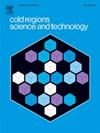Advances in icephobic coatings: Concepts, mechanisms, classifications and prospects
IF 3.8
2区 工程技术
Q1 ENGINEERING, CIVIL
引用次数: 0
Abstract
Ice accumulation on critical infrastructure, such as power grids, wind turbines, aircraft, and offshore platforms, poses significant safety risks and economic challenges. Icephobic coatings, designed to reduce ice adhesion and enable natural ice removal, offer an effective solution to mitigate these hazards. This review examines the dangers of surface icing, evaluates current anti/de-icing methods, and explores the mechanisms of icing and ice-material interactions. Key topics include various icephobic coating strategies, such as low surface energy coatings, superhydrophobic coatings, slippery liquid-infused porous surfaces (SLIPS), sacrificial coatings, polyelectrolyte brush coatings, low-modulus elastomer coatings, stress localization coatings, low interfacial toughness coatings, and antifreeze proteins (AFPs) coatings, and their effectiveness and mechanisms. Methods for measuring ice adhesion and the role of computational simulations in advancing icephobic materials are also discussed. The review concludes with insights into future research directions for icephobic coatings.
疏冰涂料的研究进展:概念、机理、分类与展望
电网、风力涡轮机、飞机和海上平台等关键基础设施上的积冰构成了重大的安全风险和经济挑战。防冰涂层的设计初衷是减少冰的粘附,实现自然除冰,为减轻这些危害提供了有效的解决方案。本文综述了表面结冰的危险,评估了目前的防冰/除冰方法,并探讨了结冰和冰-物质相互作用的机制。关键主题包括各种疏冰涂层策略,如低表面能涂层、超疏水涂层、湿滑液体注入多孔表面(slip)、牺牲涂层、聚电解质刷涂层、低模量弹性体涂层、应力局部化涂层、低界面韧性涂层和防冻蛋白(AFPs)涂层,以及它们的有效性和机理。本文还讨论了测量冰粘附的方法和计算模拟在研制疏冰材料中的作用。最后对疏冰涂料的未来研究方向进行了展望。
本文章由计算机程序翻译,如有差异,请以英文原文为准。
求助全文
约1分钟内获得全文
求助全文
来源期刊

Cold Regions Science and Technology
工程技术-地球科学综合
CiteScore
7.40
自引率
12.20%
发文量
209
审稿时长
4.9 months
期刊介绍:
Cold Regions Science and Technology is an international journal dealing with the science and technical problems of cold environments in both the polar regions and more temperate locations. It includes fundamental aspects of cryospheric sciences which have applications for cold regions problems as well as engineering topics which relate to the cryosphere.
Emphasis is given to applied science with broad coverage of the physical and mechanical aspects of ice (including glaciers and sea ice), snow and snow avalanches, ice-water systems, ice-bonded soils and permafrost.
Relevant aspects of Earth science, materials science, offshore and river ice engineering are also of primary interest. These include icing of ships and structures as well as trafficability in cold environments. Technological advances for cold regions in research, development, and engineering practice are relevant to the journal. Theoretical papers must include a detailed discussion of the potential application of the theory to address cold regions problems. The journal serves a wide range of specialists, providing a medium for interdisciplinary communication and a convenient source of reference.
 求助内容:
求助内容: 应助结果提醒方式:
应助结果提醒方式:


